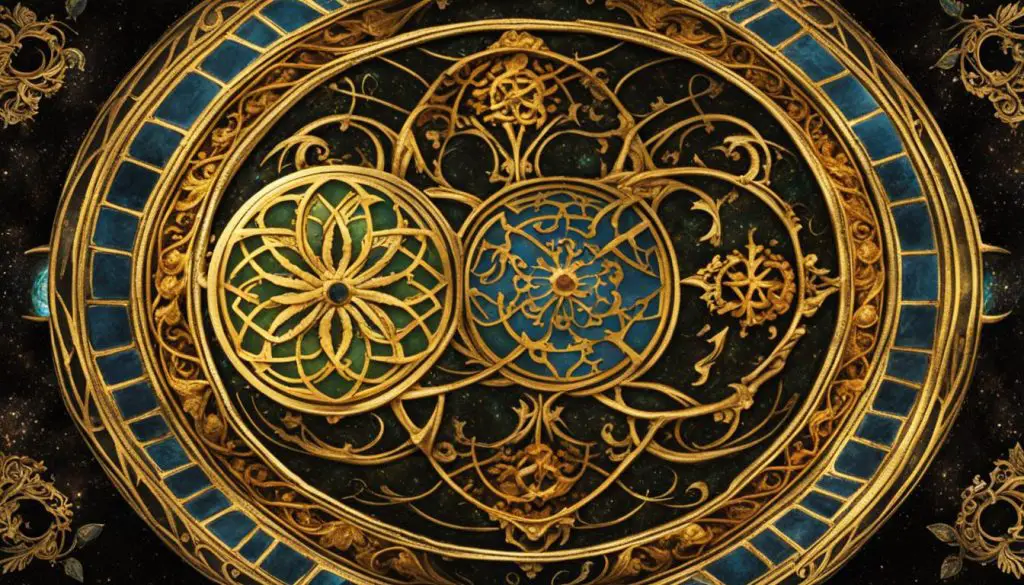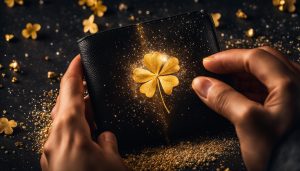In the practice of casting circles for spells and rituals, the direction in which a circle is swept is believed to have an impact on attracting good luck and positive energy. According to Scott Cunningham, a circle is a temporary space for practicing magic or conducting rituals. It acts as a protective boundary and creates the proper atmosphere for the rites. The circle can be cast anywhere, and its size can depend on the practitioner’s intent. The circle can be swept in a clockwise direction for good luck and positive outcomes, aligning with the flow of energy. This traditional circle sweeping direction is believed to enhance fortune and create a sacred inner temple for spellcasting.
Contents
- 1 The Significance of Circle Direction for Good Luck
- 2 Circle Turning Direction for Good Luck in Wicca
- 3 Circle Sweeping Techniques in Other Pagan Traditions
- 4 Conclusion
- 5 FAQ
- 5.1 Which direction should a circle be swept for good luck?
- 5.2 What is the significance of circle direction for good luck?
- 5.3 What is the circle turning direction for good luck in Wicca?
- 5.4 What are the circle sweeping techniques in other pagan traditions?
- 5.5 Is clockwise circle sweeping necessary for attracting good luck?
- 5.6 Can I experiment with circle sweeping techniques for good luck?
- 6 Source Links
Key Takeaways:
- The direction in which a circle is swept holds symbolic meanings and associations with attracting luck and auspiciousness.
- Sweeping a circle in a clockwise direction is believed to align with the natural flow of energy and draw positive forces.
- Counterclockwise circle motion is associated with banishing negative energies or releasing unwanted influences.
- In Wicca, clockwise circle turning, or “deosil,” is the customary practice for amplifying positive energy.
- While clockwise circle sweeping is common in Wicca, other pagan traditions may have different approaches or may not follow specific sweeping directions.
The Significance of Circle Direction for Good Luck
When it comes to attracting good luck and positive energy, the direction in which a circle is swept holds symbolic meanings and associations. In many magical practices, sweeping a circle in a clockwise direction is believed to align with the natural flow of energy and draw in positive forces. This motion is seen as a way to invite good luck and open up channels for blessings to enter. On the other hand, counterclockwise circle motion is often associated with banishing negative energies or releasing unwanted influences.
While the choice of circle direction can vary depending on personal beliefs and cultural traditions, clockwise circle sweeping is generally considered the standard for attracting good luck and positive outcomes. This tradition has its roots in the belief that clockwise motion follows the course of the sun and represents growth, progress, and the manifestation of desires.
“When you sweep the circle clockwise, you are essentially creating a harmonious path for positive energy to flow into your spell or ritual,” explains renowned practitioner Scott Cunningham. “It’s like opening a door and inviting good fortune into your sacred space.”
“When you sweep the circle clockwise, you are essentially creating a harmonious path for positive energy to flow into your spell or ritual. It’s like opening a door and inviting good fortune into your sacred space.” – Scott Cunningham
It’s important to note that the significance of circle direction may vary in different magical traditions and spiritual paths. In Wicca, for example, casting circles in a clockwise direction is customary and believed to enhance the effectiveness of spells and rituals. However, not all pagan traditions adhere to this approach. Norse, Egyptian, and many folk magic practitioners may not cast circles or follow specific sweeping directions, as the decision to do so depends on individual beliefs and the intention of the ritual or spell.
Ultimately, whether you choose to cast a circle and the direction in which you sweep it for good luck is a personal choice. Trust your intuition and find a method that resonates with your own spiritual path, taking inspiration from various traditions and adapting practices to suit your needs. Experimentation and personal experience will guide you to your own understanding of circle sweeping for good luck and positive energy.
Table: Symbolism of Circle Sweeping Direction
| Direction | Symbolism |
|---|---|
| Clockwise | Alignment with the natural flow of energy, inviting good luck and positive forces |
| Counterclockwise | Banishing negative energies, releasing unwanted influences |
Circle Turning Direction for Good Luck in Wicca
In Wicca, the turning direction of a circle is often associated with different magical intentions and energies. The customary practice in Wicca is to cast circles in a clockwise direction, also known as “deosil.” This motion is believed to amplify positive energy and enhance the effectiveness of spells and rituals. The clockwise movement is seen as a way to align with the natural flow of the universe and harness its supportive forces. By turning the circle in this direction, Wiccans seek to create an atmosphere of abundance, prosperity, and good fortune for their magical workings. It is important to note that the direction of circle turning may vary in different magical traditions and personal preferences.
Within the Wiccan tradition, there are various rituals and practices that involve circle turning for different purposes. One common ritual is the “Casting the Circle,” where the practitioner uses their athame or wand to physically trace the circle’s outline in a clockwise direction. This act not only creates a sacred space but also invokes protective energies and establishes a connection with the divine. The clockwise motion represents the cyclical nature of life and the continuous flow of energy. It is believed to bring harmony and balance to the magical workings within the circle.
The Power of Intentions and Personal Beliefs
While the clockwise direction is widely followed in Wicca, it is important to remember that personal beliefs and intentions hold significant power in magic. Some practitioners may choose to turn their circle counterclockwise or in a different direction based on their specific intentions or the magical tradition they follow. The ultimate goal is to align with one’s personal beliefs and work with the energies that resonate most strongly. Whether following traditional practices or adapting them to fit individual needs, the key factor is the intention behind the circle turning and the conscious connection with the divine energies.
In conclusion, the turning direction of a circle in Wicca holds symbolic significance and is believed to influence the flow of energy and attract good luck. The clockwise motion is the customary practice, aligning with the natural flow of the universe and enhancing the effectiveness of spells and rituals. However, personal beliefs, preferences, and specific magical traditions may influence the choice of circle turning direction. Ultimately, it is the intention and connection with divine energies that guide the practitioner in harnessing the power of circle turning for good luck and auspiciousness.

| Pros | Cons |
|---|---|
| Aligns with the natural flow of energy | May not align with all personal beliefs or magical traditions |
| Enhances the effectiveness of spells and rituals | May require adaptation for specific intentions |
| Creates an atmosphere of abundance, prosperity, and good fortune | Personal preferences may vary |
Circle Sweeping Techniques in Other Pagan Traditions
While clockwise circle sweeping is commonly practiced in Wicca, not all pagan traditions adhere to this approach. Norse, Egyptian, and many folk magic practitioners, for example, do not necessarily cast circles or follow specific sweeping directions. The decision to cast a circle and the choice of direction may vary depending on individual beliefs and the intention of the ritual or spell. Some eclectic pagans may choose to incorporate circle sweeping in their practice for the purpose of concentrating energy and creating a sacred space, while others may prefer different methods of working with energy. The freedom to explore and adapt circle sweeping techniques is a personal choice within pagan spiritual practices.
In Norse pagan traditions, circle sweeping is not as emphasized as in other practices. Instead, the focus is often on creating a sacred space through the use of symbols, chants, and invocations. Norse practitioners may choose to work with specific deities or invoke ancestral spirits without the need for a circled boundary. The intention behind the ritual or spell may determine the movements and gestures used, rather than adhering to a specific sweeping direction. It is important to note that Norse paganism encompasses a wide range of practices and beliefs, and approaches may differ between individuals and kindreds.
In Egyptian paganism, circle casting is not a prevalent practice. Instead, rituals and spells often involve invoking the deities and working with symbolic objects and incantations. The focus is on connecting with the divine and seeking their guidance and blessings. The direction in which a circle would be swept, if at all, would depend on the specific ritual or spell being performed. Egyptian paganism is a rich and complex tradition, with different schools of thought and practices, so the approach to circle sweeping may vary among its practitioners.
| Pagan Tradition | Circle Sweeping | Focus |
|---|---|---|
| Norse Paganism | Not Emphasized | Creating Sacred Space Through Symbols, Chants, and Invocations |
| Egyptian Paganism | Not Prevalent | Connecting with Deities Through Rituals and Incantations |
| Folk Magic | Varies | Adaptation and Personal Practices |
Ultimately, the practice of circle sweeping in pagan traditions outside of Wicca is diverse and often dependent on personal preferences and cultural influences. Whether one chooses to incorporate circle sweeping, the direction chosen, or even if a circle is necessary at all, is a matter of individual interpretation and the specific spiritual path they follow. What remains consistent across pagan traditions is the intention to create a sacred space and connect with the divine, with each practitioner finding their own unique way to do so.
Conclusion
Circle sweeping direction for good luck is a topic that varies among different magical traditions and personal beliefs. While clockwise circle sweeping is often associated with attracting luck and positive energy, it is important to remember that beliefs and practices can vary. Whether one chooses to cast a circle, the direction of the sweep, or even if a circle is necessary at all, is ultimately up to the practitioner.
The key is to trust one’s intuition and find a method that resonates with their own spiritual path. Experimentation and personal experience will ultimately guide each practitioner to their own understanding of circle sweeping for good luck.
FAQ
Which direction should a circle be swept for good luck?
According to traditional beliefs, a circle should be swept in a clockwise direction to attract good luck and positive energy.
What is the significance of circle direction for good luck?
Sweeping a circle in a clockwise direction is believed to align with the natural flow of energy and invite positive forces and blessings into the space.
What is the circle turning direction for good luck in Wicca?
In Wicca, it is customary to cast circles in a clockwise direction, also known as “deosil,” to enhance the effectiveness of spells and rituals and create an atmosphere of abundance and good fortune.
What are the circle sweeping techniques in other pagan traditions?
Circle sweeping and the choice of direction may vary in different pagan traditions. Some practitioners, like Norse, Egyptian, and folk magic practitioners, may not necessarily cast circles or follow specific sweeping directions.
Is clockwise circle sweeping necessary for attracting good luck?
The decision to cast a circle, the choice of direction, and even the necessity of a circle vary depending on personal beliefs and the intention of the ritual or spell. Some practitioners may choose to incorporate clockwise circle sweeping to concentrate energy and create a sacred space, while others may prefer different methods of working with energy.
Can I experiment with circle sweeping techniques for good luck?
Absolutely! Circle sweeping direction for good luck is a topic that varies among different magical traditions and personal beliefs. Trust your intuition and find a method that resonates with your own spiritual path. Experimentation and personal experience will ultimately guide you to your own understanding of circle sweeping for good luck.





